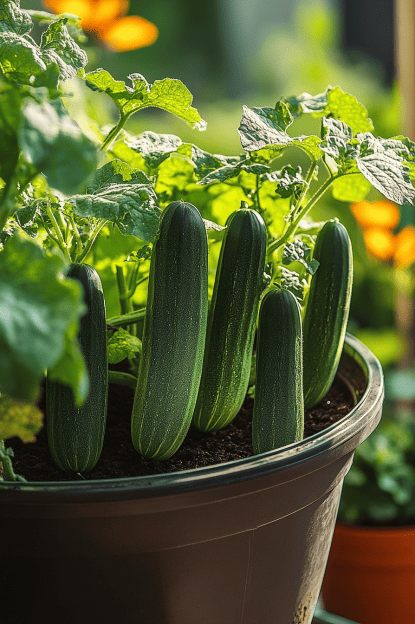Growing Cucumbers for Fresh Salads: Complete Guide—Cucumbers are a refreshing addition to any salad, and growing them at home ensures you always have fresh, crisp cucumbers on hand. In this guide, we’ll walk you through everything you need to know to grow cucumbers successfully, whether you’re a beginner or experienced gardener. With this complete guide, you’ll master the essentials of growing cucumbers for fresh salads right in your own backyard.
1. Introduction: Growing Cucumbers for Fresh Salads
Why Grow Cucumbers at Home?
- Fresh and Flavorful: Homegrown cucumbers are fresher, tastier, and free from harmful chemicals.
- Variety and Versatility: Cucumbers can be used in salads, pickles, or even infused water, making them a versatile garden addition.
Cucumber Varieties to Choose From
Different cucumber varieties work best for specific uses, so it’s essential to choose the right one for your garden.
English Cucumbers
- Long and Seedless: Ideal for salads due to their mild flavor and lack of seeds.
Persian Cucumbers
- Crisp and Small: Perfect for fresh salads and snacking.
Kirby Cucumbers
- Best for Pickling: These small, crunchy cucumbers are great for pickles but can also be used in salads.

2. How to Start Growing Cucumbers for Fresh Salads at Home
Start from Seeds vs. Transplants
Cucumbers can be grown from seeds or transplants. Starting from seeds allows for more variety, while transplants offer a quicker start to the season.
When to Plant Cucumbers
Cucumbers thrive in warm weather. Plant seeds after the last frost, when the soil has warmed to at least 60°F.
Growing Cucumbers Indoors vs. Outdoors
- Indoors: Grow cucumbers indoors if you have limited outdoor space or want an earlier start.
- Outdoors: Cucumbers flourish in outdoor gardens where they get plenty of sunlight.
3. Preparing the Right Environment for Growing Cucumbers
Soil Requirements
Cucumbers prefer nutrient-rich, well-drained soil with a slightly acidic to neutral pH (6.0-7.0). Adding compost or organic matter helps improve soil quality.
Sunlight and Watering Needs
- Sunlight: Cucumbers need 6-8 hours of direct sunlight daily.
- Watering: Keep the soil consistently moist, but avoid waterlogging. Deep watering once or twice a week is ideal.
4. Complete Guide to Planting and Caring for Cucumbers
Proper Plant Spacing
Space cucumber plants about 12-18 inches apart to ensure proper airflow and room for growth. For vines, provide enough space to spread.
For anyone following this Complete Guide to Growing Cucumbers for Fresh Salads, selecting the right soil and sunlight conditions is essential to achieve the best results.
This Growing Cucumbers for Fresh Salads: Complete Guide also includes important tips on watering, pruning, and pest control to help your cucumber plants thrive and produce a bountiful harvest.
Trellising and Vertical Gardening
Trellising helps cucumbers grow vertically, saving space and improving air circulation. This method also makes harvesting easier and keeps cucumbers clean.
Pruning Cucumber Plants
Prune the lower leaves and suckers to improve air circulation and direct energy toward fruit production. This prevents diseases and enhances yield.
5. Fertilizing and Mulching for Healthier Cucumbers
Fertilizing Cucumbers Throughout Growth Stages
Use organic fertilizers like compost or fish emulsion during planting and throughout the growing season. Apply fertilizer every few weeks to encourage healthy growth.
Mulching to Retain Moisture
Mulching with straw or leaves helps retain soil moisture and suppress weeds. It also keeps the soil temperature steady, which cucumbers prefer.
For more details on organic fertilizing techniques, check out this guide on growing potatoes.
6. Managing Common Pests and Diseases When Growing Cucumbers
Identifying Common Pests
Aphids, cucumber beetles, and spider mites are common pests that can harm your plants. Use insecticidal soap or neem oil to keep these pests in check.
Diseases Affecting Cucumber Plants
Powdery mildew and mosaic virus are common diseases affecting cucumbers. To prevent disease, ensure good air circulation and avoid overhead watering.
7. Harvesting and Storing Homegrown Cucumbers for Fresh Salads
When to Harvest Cucumbers
Cucumbers are ready to harvest when they are firm and green. Avoid leaving them on the vine too long, as they can become bitter and overripe.
Best Ways to Store Cucumbers
Store cucumbers in the refrigerator for up to a week. If you have a large harvest, consider pickling to preserve them for longer.
For more tips on storing cucumbers, visit this guide on The Old Farmer’s Almanac.
8. Essential Tips for Maximizing Cucumber Yield in Your Garden
Companion Planting with Cucumbers
Grow cucumbers alongside plants like beans and marigolds to enhance growth and deter pests naturally. Avoid planting cucumbers near herbs like sage, which can inhibit growth.
Succession Planting for Continuous Harvest
By planting cucumbers every 2-3 weeks, you can enjoy a continuous harvest throughout the growing season.
Frequently Asked Questions (FAQs)
Q: What are the best cucumber varieties for salads?
A: English cucumbers and Persian cucumbers are the best choices for crisp, fresh salads.
Q: Can cucumbers grow in containers?
A: Yes! Cucumbers grow well in containers as long as they have enough depth and space to spread.
Q: How do I prevent my cucumbers from tasting bitter?
A: Bitter cucumbers often result from inconsistent watering or leaving them on the vine too long. Maintain consistent soil moisture and harvest regularly to avoid bitterness.
Conclusion
Recap of Key Tips for Growing Cucumbers
Growing cucumbers at home is an easy and rewarding process. With the right variety, care, and growing conditions, you can enjoy fresh, crisp cucumbers all season long.
Start Your Own Cucumber Garden
Whether you’re growing in the garden or containers, now is the perfect time to start your cucumber garden and enjoy the benefits of homegrown produce!


1 thought on “Growing Cucumbers for Fresh Salads: Complete Guide”